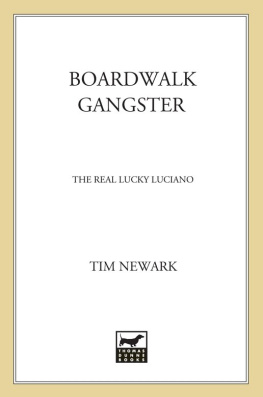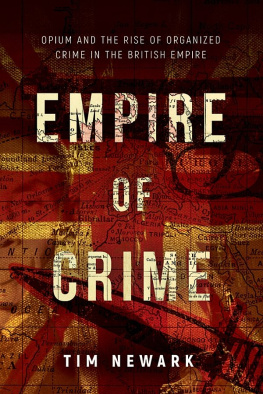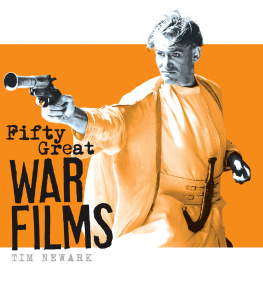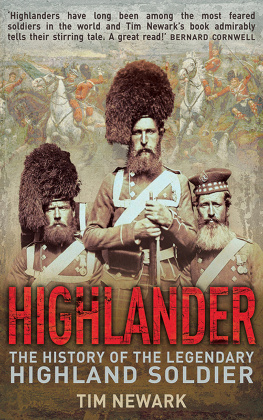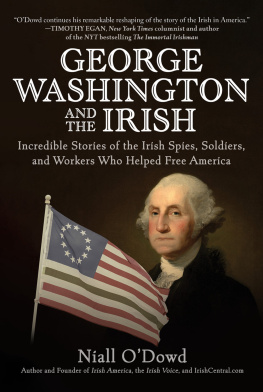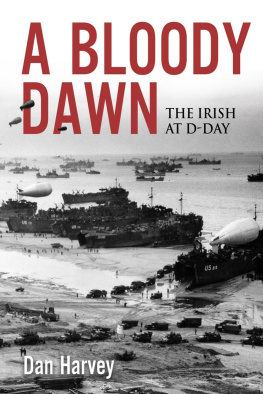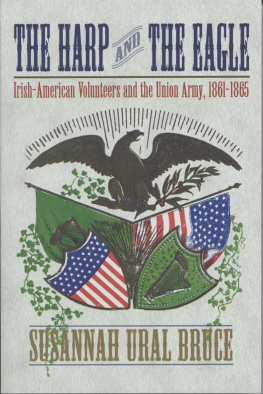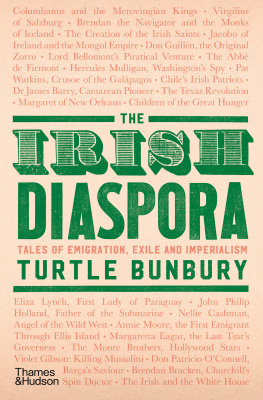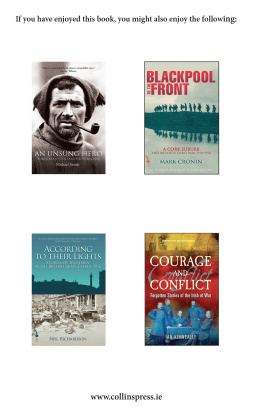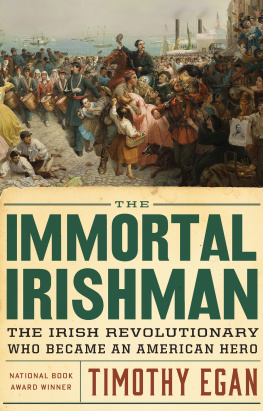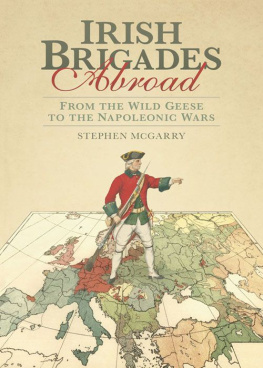THE FIGHTING IRISH
By the same author
Medieval Warfare
The Barbarians
Celtic Warriors
Medieval Warlords
Women Warlords
The Art of Emile Galle
Brasseys Book of Camouflage
Brasseys Book of Uniforms
War in Britain
Where They Fell
In Heroes Footsteps
Turning the Tide of War
The Mafia at War/Mafia Allies
Camouflage
Highlander
Lucky Luciano
Empire of Crime

Constable & Robinson Ltd
5556 Russell Square
London WC1B 4HP
www.constablerobinson.com
First published in the UK by Constable,
an imprint of Constable & Robinson Ltd, 2012
Copyright Tim Newark, 2012
The right of Tim Newark to be identified as the author of this work has been asserted by him in accordance with the Copyright, Designs and Patents Act, 1988.
All rights reserved. This book is sold subject to the condition that it shall not, by way of trade or otherwise, be lent, re-sold, hired out or otherwise circulated in any form of binding or cover other than that in which it is published and without a similar condition being imposed on the subsequent purchaser.
A copy of the British Library Cataloguing in Publication Data is available from the British Library.
ISBN: 978-1-84901-515-8
eISBN: 978-1-78033-511-7
1 3 5 7 9 10 8 6 4 2
Printed and bound in the UK
To Max Newark,
a tough little soldier
The Fighting Irish is a must-read for anyone wanting to know how such a small nation can provide some of the worlds finest fighting men.
Captain Doug Beattie MC, 1st Battalion, Royal Irish Regiment
Acknowledgements
Thanks to the following individuals and institutions who helped me in my research for this book in Britain, Ireland and the USA: David Read of the Soldiers of Gloucestershire Museum, Gloucester; Captain Doug Beattie MC, 1st Royal Irish Regiment; Elizabeth McEvoy, Archivist, National Archives of Ireland, Dublin; Irish Newspapers Archive; Terence Nelson, Royal Ulster Rifles Regimental Museum, Belfast; Sean Longden; Kieran Lynch; Gerry White; Robert Doyle; Peter and Ollie Newark for their picture archive; the staff of the British Library, Kings Cross, and The National Archives, Kew; Richard OSullivan for the Second World War memoirs of his father, Edmund, London Irish Rifles; John Gorman for his memories of Jadotville, and Austin Berry, former mayor of Athlone; Captain Nigel Wilkinson, London Irish Rifles Regimental Association; Henry OKane, Royal Ulster Rifles, for his memories of Korea; Glenn Thompson for showing me around the excellent Irish at War at Home and Abroad exhibition at the National Museum of Ireland, Collins Barracks, Dublin; Captain Brandon Gendron, 1st 69th Infantry Regiment, US Army, for showing me the Irish bar of the Fighting 69th at the Lexington Avenue Armory, New York, and Staff Sergeant Brandon Luchsinger; Company Sergeant Major Dominic Hagans, Royal Irish Regiment, for his memories of Iraq and Afghanistan. Special thanks to Chris Newark for his advice and good company in Ireland. Thanks also to my first-class agent Andrew Lownie and excellent publisher Leo Hollis.
List of Illustrations
Introduction
One evening in 1815, a cattle farmer was sitting on the verandah of his house in the province of Corrientes in northern Argentina, near the border with Paraguay, when he was approached by a stranger a tall, raw boned, ferocious looking man, dressed as a gaucho with two cavalry pistols stuck in his waistband and a sabre in a rusty steel scabbard hanging from his belt. The farmer feared he was a bandit, but when the stranger opened his mouth, he spoke a mangled Spanish with a strong Irish accent.
I am Don Pedro Campbell, he announced.
He was, in fact, Peter Campbell from western Ireland, formerly of the 71st Highland Regiment garrisoned in County Galway. What was this Irishman doing so far from home? His dramatic appearance on a faraway plain epitomizes the extraordinary journey undertaken by so many Irishmen in foreign military service.
For hundreds of years, Irish soldiers have sought their destiny abroad. Stepping aboard ships bound for England, America, or Europe, young Irishmen have been hungry for adventure, a self-made fortune, or the means to carry on a cause back home. The horrendous rift caused by differing religious beliefs or a desire for independent nationhood encouraged many Irishmen to travel abroad, seeking allies to help them in their long battle against Britain.
The battle of the Boyne is my starting point for this saga as Irish Catholics and Protestants fought for who would rule their country. As result of their defeat at the hands of the Protestant Williamite forces, many Catholic soldiers sailed abroad to enrol in the armies of the king of France, setting a pattern for future foreign military service. Leaving their birthplace, they travelled with hope and a romantic dream in their heart, perhaps wanting to return home in due course to bring a liberating revolution to their fellow countrymen; frequently, however, they were disappointed and recruited into the armies of foreign tyrants, among them Napoleon Bonaparte.
Many more Irishmen have set sail with less lofty ideals in mind, escaping poverty, or just wishing to make their own way in the world and impress the girls back home. Many of them took employment with the British Army at one time making up over 40 per cent of Queen Victorias army. These red-coated Irishmen travelled to all corners of the British Empire, winning new territories and a reputation as fearless soldiers. Some sailed to America and joined in frontier fighting or demonstrated their loyalty to their new homeland in the bloody combats of the American Civil War. Some took the opportunity to carry on their home-born disputes with campaigns against the British Empire in Canada and South Africa.
In the twentieth century, the bitter conflicts of an Ireland seeking independence have been overshadowed by the far greater sacrifice of Irishmen fighting overseas against Germany in two world wars or serving in Cold War expeditions as part of United Nations armies. This book is about all those Irishmen fighting abroad, their triumphs and their failures in foreign lands, and their individual motivations for risking their lives so far from home.
Sometimes the price of adventure can be high, as Dominic Hagans, Company Sergeant Major in the Royal Irish Regiment found out when his Land Rover was blown up by a roadside bomb in Afghanistan. Badly injured, he was nevertheless keen to return to the battlefield.
To be honest, if they said to me tomorrow youre going back, my Bergen would be packed, says Hagans, and Id be on the first plane out, because thats what we are trained to do and thats what we want to do. You dont join the army to drink loads of beer. You join to go to war.
It is this irrepressible fighting spirit that has made the Irish soldier abroad such a distinctive character, much respected by other nations, and is the inspiration for my book.
Tim Newark, 2009
Chapter 1
On the Banks of the Boyne
The great hatred between Irish Catholics and Protestants reached a climax on the banks of the River Boyne on 1 July 1690. A hundred years of violent animosity born out of the Reformation that split Europe along frontiers of faith would be settled on this boggy land. The river flowed through the town of Drogheda, just two miles to the west of the battlefield. Forty-one years earlier, Drogheda had been the site of a notorious siege in which the Protestant Oliver Cromwells English Parliamentarians had stormed the town and slaughtered its Royalist garrison among them many Irish Catholics. This ruthless religious contest between Protestants and Catholics, in which little mercy was shown, fired up the soldiers as they glowered across the River Boyne at each other on that summer morning in 1690. The result of this conflict would echo across centuries of Irish history and determine the fate of many young Irishmen.
Next page

